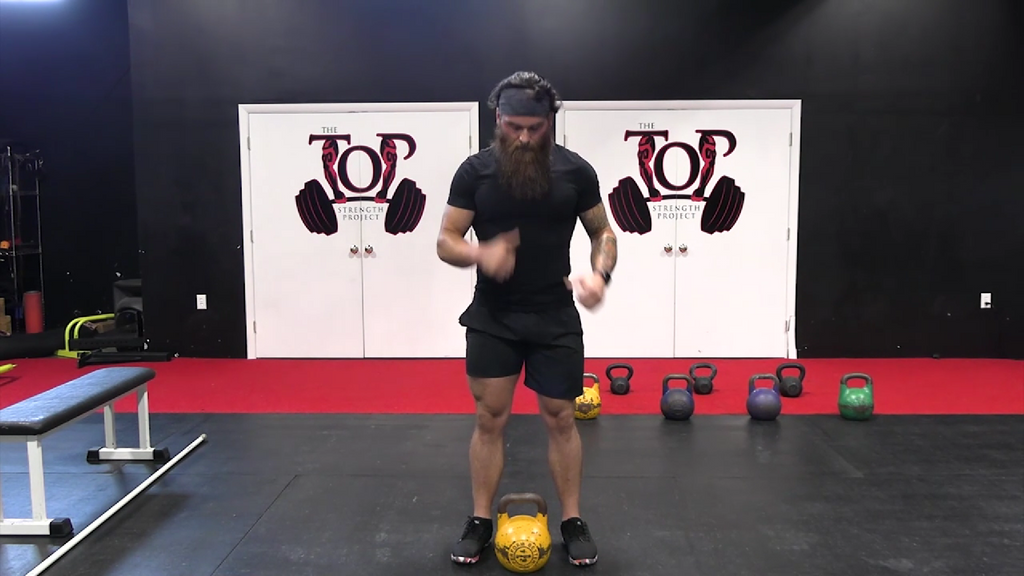
Unlocking Pectoral Power with the Kettlebell Fly
The kettlebell fly is a unique and effective exercise designed to target the pectoral muscles while engaging the stabilizing muscles of the shoulder and core. In this comprehensive guide, we'll delve into the muscles worked, how to execute the kettlebell fly with precision, the benefits it offers, and explore variations and complementary exercises to maximize your chest training.
What this article covers:
- Muscles Worked during Kettlebell Fly
- How to Perform the Kettlebell Fly
- Benefits of the Kettlebell Fly
- Common Mistakes and How to Avoid Them
- Variations and Progressions
- Conclusion: Elevating Your Chest Training
Muscles Worked during Kettlebell Fly
Understanding the primary muscle engagement during the kettlebell fly is essential for achieving optimal results:
Pectoralis Major (Chest Muscles):
The primary focus of the kettlebell fly is on the pectoralis major, particularly the sternal fibers. This exercise emphasizes the horizontal movement of the arms, mimicking the motion of a traditional chest fly.
Anterior Deltoids (Front Shoulders):
The anterior deltoids play a supporting role as they assist in the horizontal adduction of the arms during the fly movement.
Serratus Anterior and Core Muscles:
The serratus anterior and core muscles are activated to stabilize the shoulder blades and maintain proper form throughout the exercise.
How to Perform the Kettlebell Fly
Executing the kettlebell fly with proper form is crucial for targeting the chest muscles effectively. Follow these steps for precise execution:
Starting Position:
Lie on your back on a flat bench with a kettlebell in each hand.
Extend your arms above your chest, palms facing each other, and maintain a slight bend in the elbows.
Executing the Movement:
With a controlled motion, lower the kettlebells to the sides until your elbows are slightly below the level of the bench.
Feel a stretch in your chest, then engage the chest muscles to bring the kettlebells back to the starting position.
Keep a slight bend in the elbows throughout the movement to prevent excessive strain on the joints.
Form Tips:
Focus on a smooth and controlled movement, avoiding rapid or jerky motions.
Keep the core engaged to stabilize your torso.
Ensure your shoulder blades stay in contact with the bench to maintain proper form.
Benefits of the Kettlebell Fly
Understanding the benefits of the kettlebell fly reinforces its role in a well-rounded chest training routine:
Isolation of Chest Muscles:
The kettlebell fly isolates the chest muscles, providing targeted stimulation to the pectoralis major for enhanced muscle development.
Increased Range of Motion:
The horizontal movement of the arms in the fly motion allows for a greater range of motion compared to some traditional chest exercises, promoting improved flexibility in the chest muscles.
Balanced Chest Development:
The kettlebell fly emphasizes the sternal fibers of the pectoralis major, contributing to a well-balanced and sculpted chest appearance.
Stabilization Challenge:
The stabilizing muscles of the shoulders and core are actively engaged during the fly, promoting overall stability and reducing the risk of imbalances.
Common Mistakes and How to Avoid Them
Identifying and addressing common mistakes ensures the effectiveness and safety of the kettlebell fly:
Using Excessive Weight:
Start with a manageable weight to maintain proper form and gradually progress as your strength increases.
Neglecting Core Engagement:
Keep the core muscles engaged throughout the movement to stabilize the torso and prevent overarching of the lower back.
Variations and Progressions
Exploring variations and progressions enhances the versatility of your chest training:
Single-Arm Kettlebell Fly:
Perform the fly with one kettlebell at a time to challenge each side independently, promoting balance and addressing potential strength imbalances.
Complementary Exercise: Push-Ups
Integrate push-ups into your routine to complement the unilateral focus of the single-arm kettlebell fly. This compound movement engages the chest, shoulders, and triceps.
Incline Kettlebell Fly:
Execute the fly on an incline bench to shift the emphasis to the upper chest. This variation provides a different angle of stimulation for a well-rounded chest workout.
Complementary Exercise: Incline Dumbbell Press
Combine the incline kettlebell fly with incline dumbbell presses to target the upper chest from multiple angles, contributing to overall chest development.
Pause and Squeeze:
Introduce a brief pause at the bottom of the fly to increase time under tension and enhance the mind-muscle connection.
Complementary Exercise: Chest Dips
Incorporate chest dips into your routine to complement the pause and squeeze technique. Dips engage the chest and triceps while challenging stability.
Conclusion: Elevating Your Chest Training
The kettlebell fly, with its emphasis on chest isolation and stabilization, proves to be a valuable addition to your chest training repertoire. By understanding its benefits, executing proper form, and exploring variations, you can customize your chest workout for optimal results. Whether you're striving for balanced chest development, increased range of motion, or a challenging variation, the kettlebell fly stands as a versatile and effective exercise in sculpting a powerful chest.
Did you find the blog helpful? If so, consider checking out other guides:
- Mastering the Art of Kettlebell Chest Workouts
- Unlocking Shoulder Strength
- Unlocking Shoulder Mastery with the Kettlebell Halo
- The Russian Kettlebell Swing
- The American Kettlebell Swing
- The World of Russian Kettlebell Workouts
- Mastering the Russian Kettlebell Challenge
- The Double Kettlebell Russian Swing and Its Variations
- The Power of Kettlebell Benefits
- Exploring the Essence of Kettlebells
- Dumbbell-Kettlebell Fusion
- Why Kettlebells?
- How Many Kettlebells Do I Need?
- A Guide to Using Kettlebells
- Bodyweight and Kettlebell Workout







